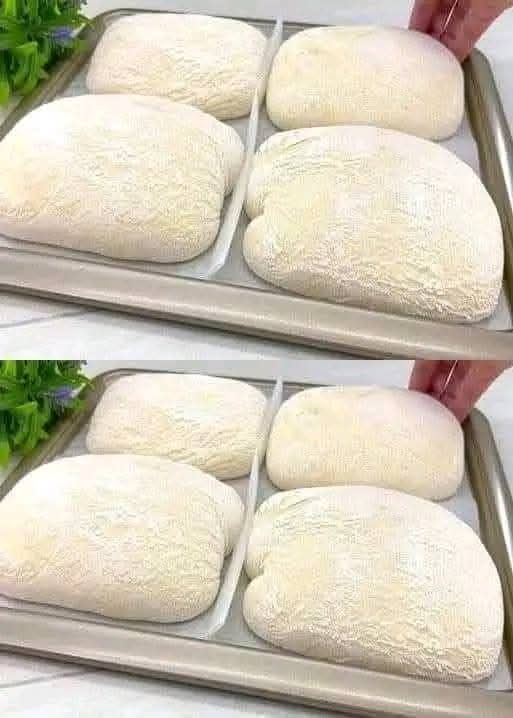Absolutely! Here’s a big, beautiful, and heartfelt recipe for Authentic No-Knead Italian Bread, complete with everything you asked for—history, ingredients, methods, love, and more. Grab your apron, because this one’s a treasure.
Authentic No-Knead Italian Bread Recipe – “Pane della Nonna”
Introduction
This rustic Italian bread, known affectionately in villages across Italy as “Pane della Nonna” (Grandma’s Bread), is a testament to the simplicity and magic of traditional European baking. It’s a no-knead dough, which means anyone can do it—no mixer, no elbow grease. Just time, patience, and love.
This recipe is perfect for cozy evenings, for dipping in olive oil, or pairing with cheese, wine, or soup. In Italy, bread is not just food—it’s culture, memory, and connection.
A Little History
Bread-making in Italy dates back thousands of years, to Roman times. In fact, archaeologists uncovered carbonized loaves in the ruins of Pompeii! Italian bread varies by region—Tuscan bread is famously saltless, while Sicilian loaves use semolina flour.
This particular no-knead recipe is inspired by the Pane Pugliese from southern Italy—crispy crust, airy interior, and that rich fermented flavor that only a slow rise can deliver.
Ingredients
- 3½ cups (440g) all-purpose flour or bread flour
- 1¾ tsp salt
- ½ tsp instant yeast
- 1½ cups (360ml) warm water (about 100°F / 38°C)
- Optional: 1 tbsp olive oil (adds flavor and softness)
- Optional: 1 tsp sugar or honey (helps activate the yeast)
- Dusting: Cornmeal or extra flour for baking surface
Tools Needed
- Large mixing bowl
- Wooden spoon or spatula
- Plastic wrap or kitchen towel
- Dutch oven or cast iron pot with lid
- Parchment paper (optional)
Method & Instructions
1. Mix the Dough
In a large bowl, combine flour, salt, and instant yeast. Stir dry ingredients briefly.
Add warm water (and olive oil/honey if using). Mix with a spoon until a shaggy, sticky dough forms.
No kneading needed. Just mix until combined.
2. First Rise (Fermentation)
Cover the bowl with plastic wrap or a towel. Let it rest at room temperature for 8 to 12 hours, or until it has doubled in size and is bubbly.
Shortcut method: If you’re short on time, you can let it rise in a warm place for 1 to 2 hours, but longer fermentation = better flavor.
3. Shape the Dough
Generously flour a surface. Turn out the dough and gently fold it over a couple of times into a round or oval shape.
Place on a floured towel or parchment, seam side down.
Cover and let rise for 30-60 minutes while your oven preheats.
4. Preheat Oven
Place a Dutch oven (with lid) in the oven and preheat to 450°F (230°C) for at least 30 minutes. The hot pot is key for steam and crust.
5. Bake the Bread
Carefully remove the hot pot from the oven.
Place the dough into the pot (use parchment if needed), cover, and bake for 30 minutes.
Remove the lid and bake for another 10-15 minutes, or until deep golden brown.
6. Cool & Serve
Let the bread cool on a rack for at least 20 minutes before slicing—this helps the inside set and keeps it moist.
The Lovers of This Bread
- Nonna Maria in Naples bakes it every Sunday.
- Luca, a street artist in Florence, eats it with pesto and wine under the stars.
- Sophia, a mom in Rome, makes it for her children with Nutella and strawberries.
- You, making it for someone you love, or just for your soul.
Serving Suggestions
- Drizzle with olive oil and balsamic vinegar
- Dip in a hot bowl of minestrone soup
- Slice for panini sandwiches
- Toast and top with bruschetta mix
- Pair with prosciutto, mozzarella, and arugula
Formation of the Bread: What’s Really Happening
- The yeast eats the sugar in the flour and releases carbon dioxide, making bubbles.
- The gluten (in flour) traps those bubbles, giving the bread its chewy texture.
- The long rise develops that deep flavor—like sourdough, but easier.
- The hot pot steams the dough, forming a crispy crust like a bakery loaf.
Conclusion
Bread is more than flour and water—it’s time, it’s history, it’s love passed from hand to hand. With this no-knead Italian bread, you’re making something that people have made for centuries with joy.
You don’t need to be a professional baker. You just need an hour, a bowl, and your heart.
If you want, I can turn this into a printable PDF or add images. Or I can give you variations—cheesy garlic version? Olive & rosemary? Let me know!
